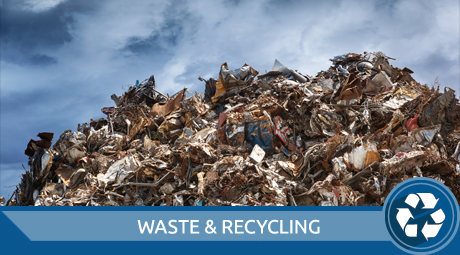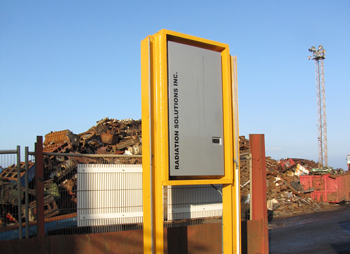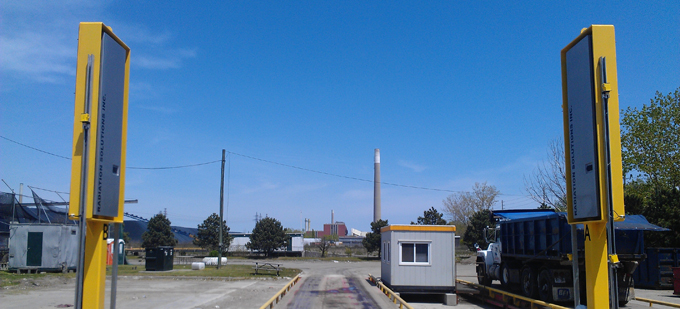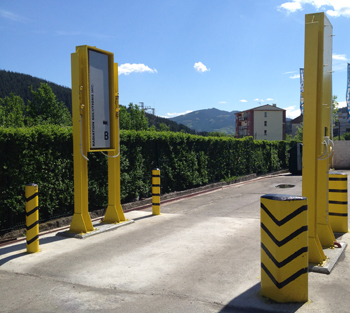RADIATION DETECTION & MONITORING TECHNOLOGIES

When radioactive materials are found in areas such as scrap metal recycling, waste handling, or incinerators, the concern becomes that undetected radioactive substances in appreciable amounts may cause unnecessary risk to members of the public, facility workers, and the environment. If these radioactive substances enter the metal recycling or waste-processing stream, they can contaminate equipment, products, and the environment, resulting in a significant financial impact due to clean-up costs.
Installed radiation portal monitor systems are used to detect the presence of radioactive substances in incoming loads of materials to a facility. RSI’s revolutionary technology is specialized for the demanding recycling environment and provides an unsurpassed detection of shielded radiation sources.

The RS-200 System is typically supplied with two detectors, although a system can be expanded up to 14 detectors. Each detector has a dual PMT based fully digital design that is specially suited for the specific operating conditions of the metal recycling industry. These systems use large volume PVT detectors for optimum vehicle coverage and combine exceptional performance with minimum false and nuisance alarms through advanced digital design and spectral analysis.
The RS-300 Systems generally have even larger volume detectors that have a triple PMT based fully digital design better suited for large vehicles or trains. The unique and advanced technology with Super-Coincidence provides for greatly improved signal collection and best spectral shape.
RSI’s CEO Dr. Jens Hovgaard is a well-known specialist in the Noise Adjusted Singular Value Decomposition (NASVD) method of spectral data analysis. This proven technology is incorporated into the RS-200 and RS-300 Radiation Detection Systems, maximizing the system’s capability to utilize full spectral analysis to find deeply buried or shielded radioactive sources, while simultaneously minimizing false and nuisance alarms.
Each of the RS-200 and RS-300 Radiation Detection Systems have Quad Optical Sensors sampled at high rates for sensing the best presence of vehicles or trains, as well as the measurement of the vehicle’s speed. Optional camera system(s) can be added to the system for visualization of the vehicle and its content.
The system operates independently, but has direct Ethernet connectivity to permit a fully integrated Plant design with RSO overview when required. USB/Serial connectivity also enables system configuration to suit the user’s needs for local displays and local or network printers.
Since the discovery of radioactive sources and materials in the common waste stream, radiation detection systems are now installed at waste handling facilities, transfer stations, dump sites, and incinerators. The RS-200 System, typically supplied with two detectors, is the system of choice for this type of application. Each detector has a dual PMT based fully digital design that is specially suited for the specific operating conditions of the waste handling industry and incinerators. These systems use large volume PVT detectors for optimum vehicle coverage and combine exceptional performance with minimum false and nuisance alarms through advanced digital design and spectral analysis.
RSI’s CEO Dr. Jens Hovgaard is a well-known specialist in the Noise Adjusted Singular Value Decomposition (NASVD) method of spectral data analysis. This proven technology is incorporated into the RS-200 Radiation Detection System, maximizing the system’s capability to utilize full spectral analysis to find deeply buried or shielded radioactive sources, while simultaneously minimizing false and nuisance alarms.

The RS-200 Radiation Detection System has Quad Optical Sensors sampled at high rates for sensing the best presence of vehicles as well as the measurement of the vehicle’s speed. Optional camera system(s) can be added to the system for visualization of the vehicle and its content.
The system operates independently, but has direct Ethernet connectivity to permit a fully integrated Plant design with RSO overview when required. USB/Serial connectivity also enables system configuration to suit the user’s needs for local displays and local or network printers.

As a result of the installation of radiation detection systems at waste handling sites, medical facilities are now installing these same systems to prevent radioactive materials or waste from leaving the facility premises.
The RS-200 System, typically supplied with one detector for object scanning or two detectors for vehicle monitoring, is the system of choice for this type of application. Each detector has a dual PMT based fully digital design that is specially suited for the specific operating conditions of medical facilities. These systems use large volume PVT detectors for optimum coverage and combine exceptional performance with minimum false and nuisance alarms through advanced digital design and spectral analysis.
RSI’s CEO Dr. Jens Hovgaard is a well-known specialist in the Noise Adjusted Singular Value Decomposition (NASVD) method of spectral data analysis. This proven technology is incorporated into the RS-200 Radiation Detection System, maximizing the system’s capability to utilize full spectral analysis to find deeply buried or shielded radioactive sources, while simultaneously minimizing false and nuisance alarms.
When used as a vehicle monitor, the RS-200 Radiation Detection System is supplied with Quad Optical Sensors that have been sampled at high rates for sensing the best presence of vehicles as well as the measurement of the vehicle’s speed. Optional camera system(s) can be added to the system for visualization of the vehicle and its content.
The system operates independently, but has direct Ethernet connectivity to permit a fully integrated Plant design with RSO overview when required. USB/Serial connectivity also enables system configuration to suit the user’s needs for local displays and local or network printers.
